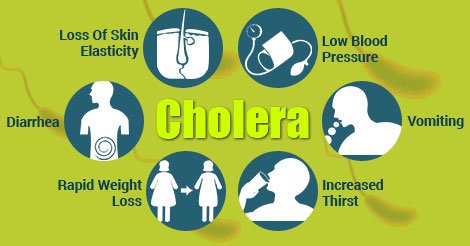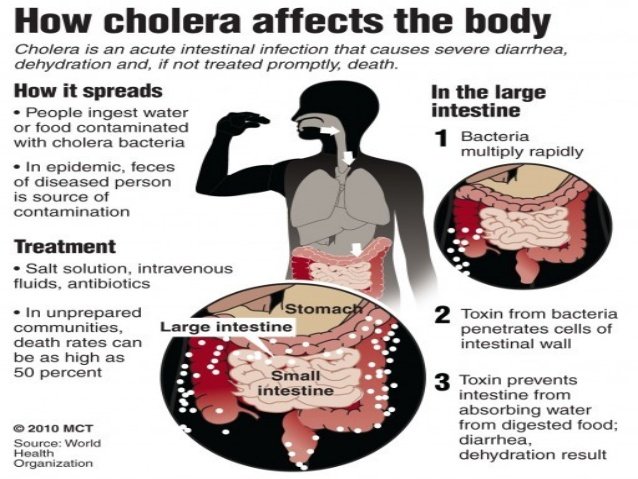Disease Report - Cholera
There are many diseases that have a substantial impact on basic bodily function, such as Cholera. Cholera is an infection to the intestines due to accidental consumption of Vibrio cholerae bacteria. This exposure is most commonly caused by tainted food or water. The infected suffer from diarrhea, dehydration, and often vomiting. Recurrence of the bacteria may appear in instances such as fish exposed to contaminated ocean waters and in the feces of those who are infected. If handled correctly, it can be both identified and treated without much trouble. Although, the infection can also be ruthless and may end in death if appropriate action is not taken. Due to its contaminating nature, widespread outbreaks may serve as an indication of the extent of a country’s development or occurrence of waste leakage.
Primarily, Cholera has a large impact on the digestive tract. It first begins with accidental consumption of tainted food or water. Upon ingestion, the bacteria travel down to the intestinal area where it will proceed to alter the functionality of the intestines. Reaching its destination, the Vibrio cholerae bacterium will cause the intestines to purge water at an excessive rate, resulting in diarrhea. Although the infection has a direct impact on the functionality of the intestines, there is no actual physical damage done. Fortunately, the infection is not highly contagious on a person-to-person basis. Because of the nature of the bacterium, the incubation period is quite small and symptoms appear rather quickly. The most predominant symptom would be recurrent, severe diarrhea. Other symptoms follow due to lack of bodily fluids including dehydration, nausea, lack of tears, lack of urine, and sleeplessness. Dehydration through excessive diarrhea alone is the true cause of death. Left without attention, Cholera can easily cause death within a few hours of infection. Multiple strains of the bacterium exist, so the exact severity of symptoms may vary from person to person. There is no specific age that holds immunity, therefore anyone and everyone is vulnerable.
Cholera is not new to the world of infectious diseases, with the first major pandemic starting in 1817. Early clues from the father of medicine, Hippocrates, may clue to the existence of related strains appearing as early as 460 BC. Outbreaks of vibrio cholerae have happened and will continue to occur in unclean, overcrowded places including locations in Africa, Asia, Europe, Mexico, India, and South America. The United States has never had a major problem with Cholera in more recent times up until the destruction involved with Hurricane Katrina. Katrina’s massive flooding made it very easy for waste to contaminate the waters and spread vibrio cholerae bacterium to the population. With the possibility of a substantial outbreak, both attention to any sudden cases and prevention through fresh food and water were crucial. Despite the infection’s seemingly intimidating onslaught, both cure and treatment are very possible. Since the cause of death is brought about by severe dehydration, patients are simply treated with hydration along with various sugar and salt supplements to aid in retention of fluids. Additional fluids through intravenous may also be used depending upon severity along with antibiotics to ease the recovery period. Vaccination is impractical at this time due to its ineffectiveness.
From a distant standpoint, Cholera is a merciless, silent killer. Upon exposure to the bacterium, there is no physical harm done to the body. Rather, the effects of the virus can very well bring about death if immediate attention is not sought. The infection thrives in areas that lack a clean environment with untainted food and water. Patients can easily be treated if they are diligent to take heed to symptoms and seek immediate medical attention


